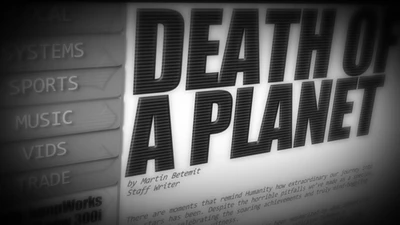NEW UNITED NewsOrg
>>
DEATH OF A PLANET
Staff Writer
There are moments that remind Humanity how extraordinary our journey into the stars has been. Despite the horrible blunders we’ve committed as a species, it is worth celebrating the soaring achievements and truly mind-boggling events we’ve come to witness.
For years, the scientific community has been mesmerized by what amounts to a ballet on a cosmic scale, after a celestial collision between a wandering asteroid and Ellis XI’s small moon began that satellite’s slow, certain plunge towards the planet’s surface. Some scientists did gather early on in enthusiastic, but inevitably fruitless, brainstorms on how to deflect the asteroid or, later, return the moon to its natural orbit. In the end, the planet’s lack of perceived value and the exorbitant costs of the proposed schemes led them to admit failure.
From then on, the scientific community’s efforts became two-pronged: half watching and studying the slow death of moon and planet like children awaiting Christmas, and the remainder performing the reams of calculations required to anticipate all of the effects – and to minimize the collateral damage. Since then, there has been a non-stop flurry of activity in almost every bureau of the UEE.
At the eye of the hurricane, Senator Clay Harren distinguished himself by spearheading the government’s response, coordinating with the High Command to implement the safety protocols to protect Ellis’s inhabited planets from the potential debris, as well as folded in mining and scientific contracts to help offset clean-up costs.
Plans were enacted. Contracts were signed. Even Xi’An scientific committees appeared to watch this cosmic event unfold. All that was left was to wait. And wait the universe did.
Finally, it happened. 6.6.2943:03:11 SET, the moon impacted the surface of Ellis XI. The silent explosion of celestial objects was beyond description. Due to the minimum distance parameters given to the media, the scene initially felt like another of the simulated images that have been saturating the Spectrum for nearly two years. It took a few moments to realize that it was real, that this scene of cosmic destruction unfolding was indeed happening.
The moon struck Ellis XI at sixteen degrees above the equator. Some analysts estimated that over ten billion megatons of energy were released during the impact – 100 times the estimated impact of the Chicxulub asteroid on Earth in prehistoric times. The size of the impact actually moved Ellis XI a fraction of a degree out of its orbit, even while the massive tectonic activity from the collision began to tear the planet apart. The planet’s final act will be to leave a new asteroid belt as the epitaph to its epic demise.
In the aftermath of the collision, the military began to escort scientific crews into the wake of the destruction. Fortunately, Ellis X, the planet’s closest astronomical neighbor, was on the other side of the system at the time of the collision, and Ellis XII’s orbit is much more distant, so there is no significant perceived risk to either of its planetary siblings.
As the scientists now begin to study the inner workings of planets on an unprecedented scale, what does this event mean for the rest of the UEE? As far as a death of a planet goes, one couldn’t ask for a better candidate. Since Ellis XI was not an inhabited planet, there are no settlers to be relocated. The planet held little interest for mining or scientific communities. At best, Ellis System will simply require a few months of travel warnings and an update to the System Almanac and Galactic Guide to excise the deceased world and add a new asteroid belt.
Although that’s not entirely true. Outside of the science and mining community, the destruction of Ellis XI holds significant value to another organization: the Murray Cup Racing League. The MCRL has set up the Ellis System as their homebase of astro-racing and is in the process of updating their rules to accommodate for the new obstacle course in their system.
So the moment has passed. The months and months of planning and anticipation have turned what many considered to be the penultimate form of destruction into a wealth of scientific research and mineral resources.
Yes, Humanity was allowed to bear witness to the passing of a planet. That, in and of itself, is remarkable, but more so, we were in a position to learn from it which, in the opinion of this reporter, is an even greater achievement.
. . . END TRANSCRIPT
